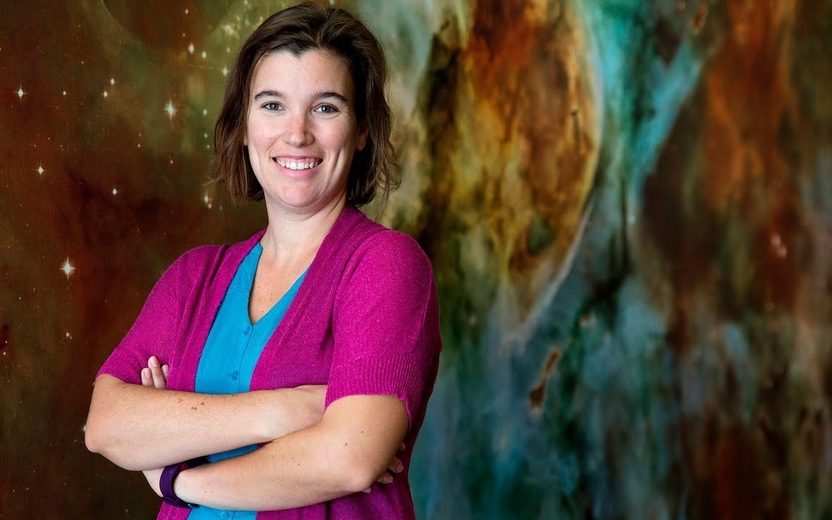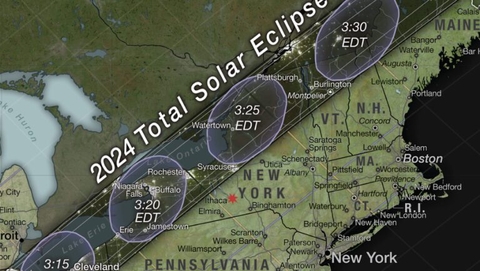Making the most of the April 8 eclipse

Abby Crites, Cornell assistant professor, physics, College of Arts and Sciences. Photo provided
Abby Crites, Cornell assistant professor, physics, College of Arts and Sciences. Photo provided.
As the total solar eclipse nears our region on April 8, I discussed the benefits of traveling the short distance to see the total eclipse, and what people can expect if they stay local to Ithaca. Is it worth the drive, or should we stay put? Ithaca is just outside the path of totality.
Abby Crites, a cosmologist at the Cornell Laboratory for Accelerator-based ScienceS & Education (CLASSE), who is building telescope cameras to peer at some of the universe’s earliest light ever created, sheds some light on how we can make the most of this celestial phenomenon happening right in our ‘backyard.’

Path of totality near Ithaca, NY. Image by NASA’s Scientific Visualization Studio
Question: Considering the infrequency of total solar eclipses, particularly those accessible to a significant portion of the United States (including Ithaca, NY) what makes the April 8th event stand out, and do you have any recommendations for those contemplating whether to travel to the path of totality to witness it?
Abby Crites: Considering how close we are to the path of the eclipse, and the fact that the next total solar eclipse won’t pass a large portion of North America until the 2040s, it may be worth traveling somewhere close by that has the potential for good weather and where you can see the eclipse in totality.
Some of the coolest things about experiencing a total eclipse is that the temperature will drop significantly when the sun is covered. Bugs and other animals will also respond to this change and often start making noise like it is evening. If you are lucky, perhaps you will notice some stars becoming visible in the middle of the day as the sun’s UV light is completely blocked. This also allows us to view the sun’s natural atmosphere, known as the corona, which is typically hidden by the stronger UV light. Viewing the corona is only possible in the path of totality.
Another interesting fact is that a solar eclipse was one of the ways that scientists showed that general relativity is correct. When the sun is blocked it’s possible to observe light from stars that would not be visible if their light was not bent by the sun’s gravity.
There are many resources that show the path of the eclipse including from NASA’s website.
I recommend giving yourself extra time for travel if you do decide to travel to the path of totality as there is often a lot of traffic.
Question: What are some practical ways to view the partial eclipse from Ithaca, and what should people expect to see?
Abby Crites: If you plan to observe the partial eclipse, you can get eclipse glasses from recommended vendors ahead of time (the American Astronomical Society has a list of vendors).
If you do not have glasses, you can simply create and use a pinhole camera made from a shoebox, a colander or anything else with small holes to project the eclipse on a surface like a sidewalk or a large sheet of paper. This will produce some interesting imagery and works by something called the camera obscura effect. This means you are blocking all but a small amount of the light coming directly from the object and projecting it on the back wall of the box. Also, take the time to look at nature’s pinhole cameras. The leaves in the trees have tiny gaps and holes in them, creating a wonderful array of crescent-shaped projections.
Question: Regarding safety, can you elaborate on the potential risks associated with directly viewing the partial eclipse in Ithaca due to the sun’s ultraviolet light, and what precautions should individuals take?
Abby Crites: You should never look directly at the sun even when it is mostly covered by the moon during an eclipse. Wear only approved eclipse glasses to look at the partial eclipse.
You should also wear sunscreen as you typically would, even though the sun is partially covered there is still a lot of UV light from the sun.
